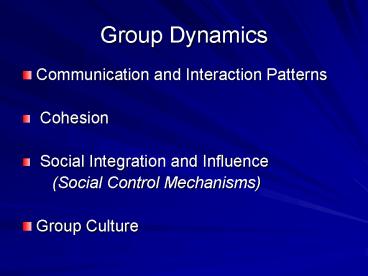Group Dynamics - PowerPoint PPT Presentation
1 / 14
Title:
Group Dynamics
Description:
Communication and Interaction Patterns 'Whenever people are together in a group, ... 3. Hot Seat extended back and forth exchange between leader and a member ... – PowerPoint PPT presentation
Number of Views:36
Avg rating:3.0/5.0
Title: Group Dynamics
1
Group Dynamics
- Communication and Interaction Patterns
- Cohesion
- Social Integration and Influence
- (Social Control Mechanisms)
- Group Culture
2
Communication and Interaction Patterns
- Whenever people are together in a group, they
are communicating. (T R) - Communication patterns can be helpful or
harmful.
3
Communication and Interaction Patterns
- Why people communicate
- 1. Understanding other people
- 2. Finding out where they stand in relation to
other people - 3. Persuading others
- 4. Gaining or maintaining power
- 5. Defending themselves
- 6. Provoking a reaction from others
- 7. Making an impression on others
- 8. Gaining and maintaining relationships
- 9. Presenting a unified image to the group
4
Communication and Interaction Patterns
- OBSERVE, ASSESS, and UNDERSTAND COMMUNICATION
AND INTERACTION PATTERNS.
5
Communication and Interaction Patterns
- Selective Perception influenced by
- 1. Life positions that result from experiences
in early childhood - 2. Values
- 3. The status and position of the
communicator - 4. Previous experiences
- 5. Assumptions
- 6. Stereotypes
- Feedback
6
Communication and Interaction Patterns
- Interaction Patterns
- 1. Maypole leader to member member to
leader - 2. Round Robin members take turns
- 3. Hot Seat extended back and forth exchange
between leader and a member - 4. Free Floating all members take
responsibility for communicating
7
Communication and Interaction Patterns
- Patterns of Interaction are influenced by
- 1. Cues and Reinforcers
- 2. Emotional Bonds
- 3. Subgroups
- 4. Size and Physical Arrangements
- 5. Power and Status
8
Cohesion
- The result of all forces acting on members to
remain in a group.
9
Cohesion
- Four interacting sets of variables determine a
members attraction to a group - 1. Need for affiliation, recognition, and
security - 2. The resources and prestige available through
participation - 3. Expectations of the beneficial and
detrimental consequences of the group - 4. Comparison of the group with other group
experiences
10
Social Integration and Influence(Social Control
Mechanisms)
- How members fit together and are accepted in a
group. - Groups are not able to function effectively
unless there is a fairly high level of social
integration among members - Social Control Mechanisms the processes by
which the group-as-a-whole gains sufficient
compliance and conformity from its members to
enable it to function in an orderly manner. - Social order and stability are prerequisites for
the formation and maintenance of a cohesive
group.
11
Social Integration and Influence
- Norms shared expectations and beliefs about
appropriate ways to act in a social situation
such as a group. - increase predictability, stability, and security
- result from what is valued, preferred, and
accepted behavior - overt or covert
12
Social Integration and Influence
- Changing Norms
- Disequilibrium unfreezing
- Return to equilibrium new norms replace old
norms refreezing
13
Social Integration and Influence
- Roles shared expectations about the functions
of individuals in the group - Status an evaluation and ranking of each
members position in the group relative to all
other members
14
Group Culture
- Values, beliefs, customs, and traditions held in
common by group members.































